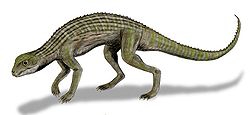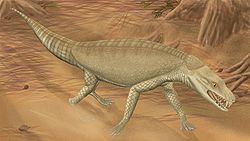
Adamantina Formation
Encyclopedia
The Adamantina Formation is a geological formation in Brazil whose strata date back to the Late Cretaceous
. Dinosaur remains are among the fossils that have been recovered from the formation. According to most studies, the Adamantina Formation dates from the Turonian
to the Santonian
stage (90-83.5 million years ago) of the late Cretaceous
, although some studies found much younger age - Campanian
to Maastrichtian
(83.5-65 million years ago) of the late Cretaceous.
Late Cretaceous
The Late Cretaceous is the younger of two epochs into which the Cretaceous period is divided in the geologic timescale. Rock strata from this epoch form the Upper Cretaceous series...
. Dinosaur remains are among the fossils that have been recovered from the formation. According to most studies, the Adamantina Formation dates from the Turonian
Turonian
The Turonian is, in the ICS' geologic timescale, the second age in the Late Cretaceous epoch, or a stage in the Upper Cretaceous series. It spans the time between 93.5 ± 0.8 Ma and 89.3 ± 1 Ma...
to the Santonian
Santonian
The Santonian is an age in the geologic timescale or a chronostratigraphic stage. It is a subdivision of the Late Cretaceous epoch or Upper Cretaceous series. It spans the time between 85.8 ± 0.7 mya and 83.5 ± 0.7 mya...
stage (90-83.5 million years ago) of the late Cretaceous
Cretaceous
The Cretaceous , derived from the Latin "creta" , usually abbreviated K for its German translation Kreide , is a geologic period and system from circa to million years ago. In the geologic timescale, the Cretaceous follows the Jurassic period and is followed by the Paleogene period of the...
, although some studies found much younger age - Campanian
Campanian
The Campanian is, in the ICS' geologic timescale, the fifth of six ages of the Late Cretaceous epoch . The Campanian spans the time from 83.5 ± 0.7 Ma to 70.6 ± 0.6 Ma ...
to Maastrichtian
Maastrichtian
The Maastrichtian is, in the ICS' geologic timescale, the latest age or upper stage of the Late Cretaceous epoch or Upper Cretaceous series, the Cretaceous period or system, and of the Mesozoic era or erathem. It spanned from 70.6 ± 0.6 Ma to 65.5 ± 0.3 Ma...
(83.5-65 million years ago) of the late Cretaceous.
Crurotarsans
| Crocodylomorphs Crocodylomorpha The Crocodylomorpha are an important group of archosaurs that include the crocodilians and their extinct relatives.During Mesozoic and early Tertiary times the Crocodylomorpha were far more diverse than they are now. Triassic forms were small, lightly built, active terrestrial animals. These were... of the Adamantina Formation |
||||||
|---|---|---|---|---|---|---|
| Genus | Species | Location | Stratigraphic position | Material | Notes | Images |
Adamantinasuchus Adamantinasuchus Adamantinasuchus is an extinct genus of notosuchian crocodylomorph from the Late Cretaceous of Brazil.-Phylogeny:Below is a cladogram modified from O’Connor et al., 2010:... |
A. navae |
A notosuchia Notosuchia Notosuchia is a suborder of primarily Gondwanan mesoeucrocodylian crocodylomorphs that lived during the Cretaceous. Fossils have been found from South America, Africa, and Asia... n |
    |
|||
Armadillosuchus Armadillosuchus Armadillosuchus is an extinct genus of sphagesaurid crocodylomorph. It was described in February 2009 from the Late Cretaceous Bauru Basin of Brazil. Sphagesaurids share a number of mammal-like features in their teeth and jaws, although they are unrelated to mammals... |
A. arrudai |
A notosuchian |
||||
Baurusuchus Baurusuchus Baurusuchus is an extinct genus of baurusuchid mesoeucrocodylian from the Late Cretaceous of Brazil. It was a terrestrial predator and scavenger, about 3.5 to 4 meters long. Baurusuchus lived during the Turonian to Santonian stages of the Late Cretaceous Period, in Adamantina Formation, Brazil... |
B. albertoi |
A baurusuchid Baurusuchidae Baurusuchidae is a Gondwanan family of mesoeucrocodylians that lived during the Late Cretaceous. It is a group of terrestrial hypercarnivorous crocodilians from South America and possibly Pakistan. Baurusuchidae has been defined as a clade containing the most recent common ancestor of Baurusuchus... |
||||
B. pachechoi |
A baurusuchid |
|||||
B. salgadoensis |
A baurusuchid |
|||||
Brasileosaurus Brasileosaurus Brasileosaurus is the name of a sparse collection of fossils that are nomen vanum-- that is, they will probably never be identified. They are believed to be the fossils of a non-dinosaurian archosaur. The type species is B... |
B. pachecoi |
|||||
Caipirasuchus Caipirasuchus Caipirasuchus is an extinct genus of sphagesaurid notosuchian known from the Late Cretaceous of São Paulo State, southeastern Brazil.-Discovery:... |
C. paulistanus |
A notosuchian |
||||
Campinasuchus Campinasuchus Campinasuchus is an extinct genus of baurusuchid mesoeucrocodylian which existed in the Minas Gerais State, Brazil during the late Cretaceous period . It is known from four partial skulls from the Honorópolis District of the Adamantina Formation, Bauru Basin. The specimens were collected at Três... |
C. dinizi |
A baurusuchid |
||||
Goniopholis Goniopholis Goniopholis is an extinct genus of crocodyliform that lived in North America, Europe and Asia during the Late Jurassic and Early Cretaceous. Being semi-aquatic it is very similar to modern crocodiles... |
G. paulistanus |
A goniopholidid Goniopholididae Goniopholididae is an extinct family of moderate-sized semi-aquatic crocodyliforms similar to living crocodiles. They lived between the Early Jurassic and the Late Cretaceous.-Geographical distribution:... |
||||
Mariliasuchus Mariliasuchus Mariliasuchus is an extinct genus of Late Cretaceous notosuchian mesoeucrocodylian found near Marilia, Brazil. It was described in 1999 by Brazilian palaeontologists Ismar de Souza Carvalho and Reinaldo J. Bertini.... |
M. amarali |
Very common. |
A notosuchian |
|||
M. robustus |
A notosuchian |
|||||
Montealtosuchus Montealtosuchus Montealtosuchus was an extinct genus of terrestrial crocodyliform. It was discovered in 2004 in the Bauru Basin of Brazil, from Turonian-Santonian deposits of the Adamantina Formation. The species was described in 2007, and assigned to the family Peirosauridae. The type species is M. arrudacamposi... |
M. arrudacamposi |
A peirosaurid Peirosauridae Peirosauridae is a Gondwanan family of mesoeucrocodylians that lived during the Cretaceous period. It was a clade of terrestrial crocodyliforms that evolved a rather dog-like form, and were terrestrial carnivores. It was phylogenetically defined in 2004 as the most recent common ancestor of... |
||||
Morrinhosuchus Morrinhosuchus Morrinhosuchus is an extinct genus of notosuchian crocodyliform from the Late Cretaceous Adamantina Formation of Brazil. It is known from a mandible and a portion of the front of the skull collected from the municipality of Monte Alto in São Paulo state... |
M. luziae |
A notosuchian |
||||
Sphagesaurus Sphagesaurus Sphagesaurus is an extinct genus of notosuchian crocodylomorph from the Late Cretaceous of Brazil.-Species and discovery:The type species S. huenei, was discovered in 1950 by Price, with the both the genus and species named from two isolated teeth. More recently a nearly complete skull of S... |
S. huenei |
A notosuchian |
||||
S. montealtensis |
A notosuchian |
|||||
Stratiotosuchus Stratiotosuchus Stratiotosuchus is an extinct genus of baurusuchid mesoeucrocodylian which existed in the Adamantina Formation, Brazil during the late Cretaceous period . It was first named by Campos, D.A., Suarez, J.M., Riff, D. and Kellner, A.W.A. in 2001 and the type species is Stratiotosuchus maxhechti... |
S. maxhechti |
A baurusuchid |
||||
Ornithodirans
Indeterminate dinosaur remains are known from the formation. Indeterminate abelisaurid remains are known from the formation. An Unnamed lithostrotian is known from the formation.| Dinosaurs of the Adamantina Formation | ||||||
|---|---|---|---|---|---|---|
| Genus | Species | Location | Stratigraphic position | Material | Notes | Images |
Adamantisaurus Adamantisaurus Adamantisaurus is a genus of titanosaurian sauropod dinosaur from the Late Cretaceous Period of what is now South America. It is only known from six tail vertebrae but, as a sauropod, it can be assumed that this dinosaur was a very large animal with a long neck and tail... |
A. mezzalirai |
 |
||||
Aeolosaurus Aeolosaurus Aeolosaurus is a genus of titanosaurian sauropod dinosaur from the Late Cretaceous Period of what is now South America. Like most sauropods, it would have been a quadrupedal herbivore with a long neck and tail... |
A. maximus |
"Single partially articulated skeleton." |
||||
Antarctosaurus Antarctosaurus Antarctosaurus is a genus of titanosaurian sauropod dinosaur from the Late Cretaceous Period of what is now South America. The type species, A. wichmannianus, was described by prolific German paleontologist Friedrich von Huene in 1929, who also described a second species in 1929. Three additional... |
"A." brasiliensis |
"Postcranial remains." |
||||
Gondwanatitan Gondwanatitan Gondwanatitan was a titanosaurian sauropod dinosaur. Gondwanatitan was found in Brazil, at the time part of the southern supercontinent Gondwana , in the late Cretaceous Period . Like some other sauropods, Gondwanatitan was tall and ate tough shoots and leaves off of the tops of trees. G... |
G. faustoi |
"Partial postcranial skeleton." |
||||
Maxakalisaurus Maxakalisaurus Maxakalisaurus is a genus of aeolosaurid dinosaur, found in Brazil, 45 kilometers from the city of Prata, in the state of Minas Gerais in 1998... |
M. topai |
|||||
?Megalosaurus Megalosaurus Megalosaurus is a genus of large meat-eating theropod dinosaurs of the Middle Jurassic period of Europe... |
Indeterminate |
Actually indeterminate theropod remains. |
||||
Titanosaurus Titanosaurus Titanosaurus is a genus of sauropod dinosaur, first described by Lydekker in 1877. It is known from the Maastrichtian Lameta Formation of India... |
T. cf. australis |
Actually indeterminate lithostrotian remains. |
||||

